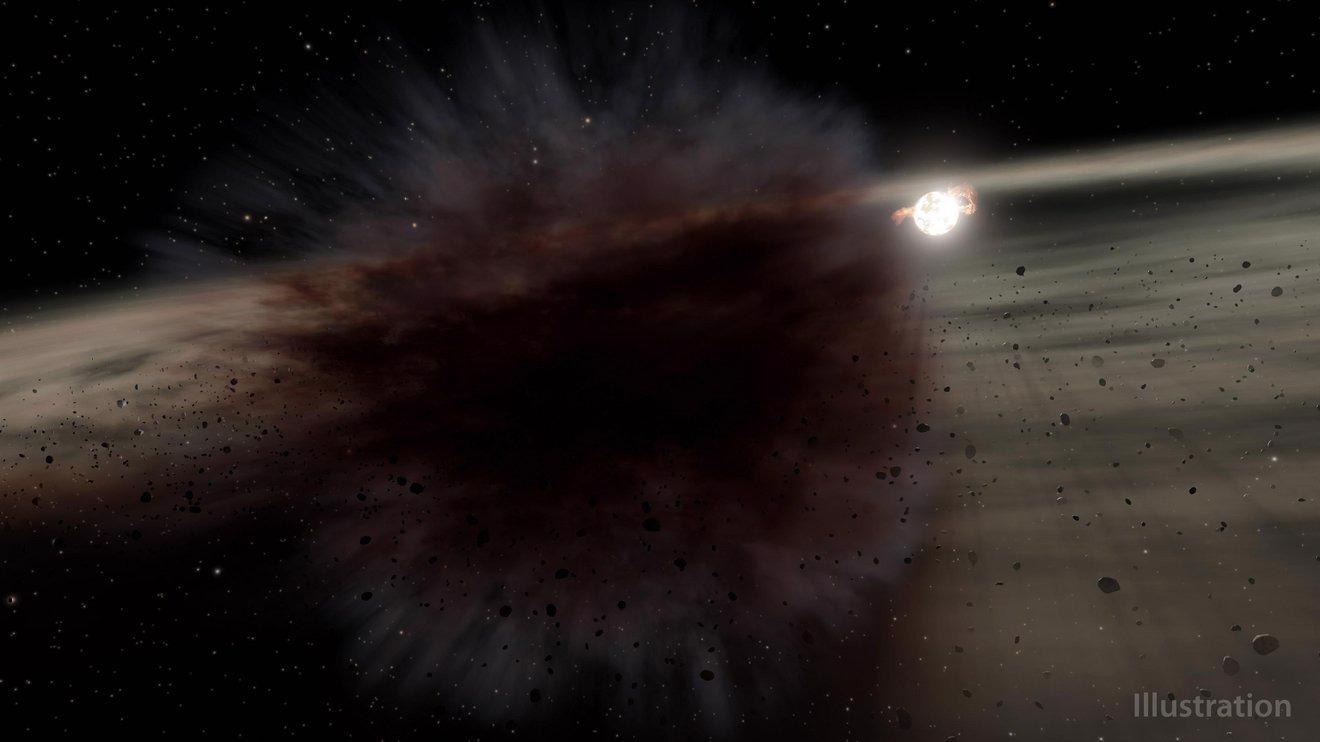Our solar system was shaped by massive collisions between rocky bodies. Observations of a similar accident provide information about how common such crashes occur near other stars.
 This illustration depicts the result of a collision between two large asteroid-sized bodies. NASA’s Spitzer saw a debris cloud block the star HD 166191, giving scientists details about the smashup that occurred. Image Credit: NASA/JPL-Caltech
This illustration depicts the result of a collision between two large asteroid-sized bodies. NASA’s Spitzer saw a debris cloud block the star HD 166191, giving scientists details about the smashup that occurred. Image Credit: NASA/JPL-Caltech
The majority of our solar system’s rocky planets and satellites, including Earth and the Moon, were formed or sculpted by huge collisions early in the system’s history. Rocky bodies can gather additional material and grow into a larger body by colliding, or they can break apart into several smaller bodies by colliding.
Astronomers had previously discovered facts of these types of collisions around young stars where rocky planets are developing using NASA’s now-retired Spitzer Space Telescope. However, such observations left out a lot of information regarding the collisions, such as the size of the items involved.
A group of astronomers headed by Kate Su of the University of Arizona claim the first sightings of a debris cloud from one of these collisions as it crossed in front of its star and quickly blocked the light. The new research was published in the Astrophysical Journal.
This is referred to as a transit by astronomers. The observations, when combined with information on the star’s size and brightness, allowed the researchers to calculate the size of the cloud immediately after impact, estimate the size of the colliding objects and track the pace with which the cloud dispersed.
There is no substitute for being an eyewitness to an event. All the cases reported previously from Spitzer have been unresolved, with only theoretical hypotheses about what the actual event and debris cloud might have looked like.
George Rieke, Study Co-Author, University of Arizona
Su headed a team that began making routine studies of HD 166191, a 10 million-year-old star, in 2015. Dust left over from a star’s creation has clumped together to create stony bodies called planetesimals, which are the seeds of future planets, around this initial point in its life. Catastrophic collisions between those items become frequent once the gas that previously filled the space between them has dissipated.
Between 2015 and 2019, the team used Spitzer to undertake more than 100 observations of HD 166191 in the hopes of finding evidence of one of these collisions. While the planetesimals are too tiny and far away to be seen with a telescope, their collisions generate a lot of dust.
Spitzer observed infrared light, which has wavelengths that are slightly longer than those seen by human eyes. Dust, such as those produced by protoplanet impacts, can be detected using infrared.
The HD 166191 system became much brighter in mid-2018, indicating a rise in debris generation, according to the satellite telescope. Spitzer also identified a debris cloud covering the star during this period. The team was able to determine the size and form of the debris cloud by combining Spitzer’s transit observations with ground-based measurements.
The cloud was unusually extended, with a minimum approximate area three times that of the star, according to their findings. The amount of infrared brightness seen by Spitzer, on the other hand, shows that just a small piece of the cloud crossed in front of the star and that the debris from the event blocked an area hundreds of times greater than the star.
The primary collision must have involved objects in the size of dwarf planets, such as Vesta in the solar system, which is 330 miles (530 kilometers) broad and positioned in the main asteroid belt between Mars and Jupiter.
The first collision produced enough energy and heat to cause part of the material to evaporate. It also triggered a chain reaction of collisions between pieces from the original collision and other small bodies in the system, resulting in a large amount of the dust Spitzer detected.
The enormous dust cloud expanded in size and transparency during the next few months, revealing that dust and other debris were fast diffusing throughout the newborn star system. The cloud that crossed in front of the star had faded by 2019, but the system still had twice as much dust as it had before Spitzer discovered it.
According to the authors of the report, this information can aid researchers in conducting experiments about how terrestrial planets begin and grow.
By looking at dusty debris disks around young stars, we can essentially look back in time and see the processes that may have shaped our own solar system. Learning about the outcome of collisions in these systems, we may also get a better idea of how frequently rocky planets form around other stars.
Kate Su, Study Lead, University of Arizona
Journal Reference:
Su, K. Y. L., et al. (2022) A Star-sized Impact-produced Dust Clump in the Terrestrial Zone of the HD 166191 System. The Astrophysical Journal. doi.org/10.3847/1538-4357/ac4bbb.